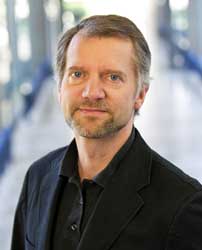
Matthias Mann
Dept. Proteomics and Signal Transduction
Max-Planck Institute of Biochemistry
www.biochem.mpg.de/mann/
Talk: “Complete proteome analysis and its uses in cell Biology and biomedicine”
Date: 16.15 Thursday, October 17
Place: Nobel Forum
Host: Gunter Schneider
Contact: Tatiana Goriatcheva, Nobelkansliet, Nobel Forum,
tel. 524 87805, tatiana.goriatcheva@nobel.se
Abstract
Proteins are generally the functional agents in cells and therefore they are a prime focus of biological and medical research. However, their analysis has traditionally been very challenging, especially compared to the great advances made in oligonucleotide-based technologies. Fortunately, this has now changed due to developments in mass spectrometry (MS)-based proteomics, which is opening up fascinating views into the complexities of the proteome (Cox and Mann, 2011). Technological advances in all areas of the shotgun proteomics pipeline now make it possible to quantify entire proteomes of model organisms such as yeast (de Godoy et al., 2008). Moreover, such a quantitative proteome map, which used to be a major and months-long undertaking, can now be performed in a matter of hours (Nagaraj et al., 2011a). Close to complete depth – in the form of quantifying at least one representative of each expressed gene – is likewise becoming possible in human systems (Nagaraj et al., 2011b). Previously limited to large cell numbers, proteomics is now also able to analyze just a few cells – a development that makes ‘visual proteomics’ – the analysis of visually selected individual cells – a realistic prospect.
Here, I will describe the current state of the technology as well as exemplary applications in the areas of expression proteomics, proteomics of post-translational modifications and interaction proteomics. Increasingly, the technology can be applied to clinical questions and I will describe the classification of cancer patients and cancer progression (Deeb et al., 2012; Wisniewski et al., 2012) as well as functional follow up of gene association studies (Butter et al., 2012) among other examples. <7p>
References:
Butter, F., Davison, L., Viturawong, T., Scheibe, M., Vermeulen, M., Todd, J.A., and Mann, M. (2012). Proteome-Wide Analysis of Disease-Associated SNPs That Show Allele-Specific Transcription Factor Binding. PLoS genetics 8, e1002982.
Cox, J., and Mann, M. (2011). Quantitative, high-resolution proteomics for data-driven systems biology. Annual review of biochemistry 80, 273-299.
de Godoy, L.M., Olsen, J.V., Cox, J., Nielsen, M.L., Hubner, N.C., Frohlich, F., Walther, T.C., and Mann, M. (2008). Comprehensive mass-spectrometry-based proteome quantification of haploid versus diploid yeast. Nature 455, 1251-1254.
Deeb, S.J., D’Souza, R.C., Cox, J., Schmidt-Supprian, M., and Mann, M. (2012). Super-SILAC allows classification of diffuse large B-cell lymphoma subtypes by their protein expression profiles. Mol Cell Proteomics 11, 77-89.
Nagaraj, N., Kulak, N.A., Cox, J., Neuhaus, N., Mayr, K., Hoerning, O., Vorm, O., and Mann, M. (2011a). Systems-wide perturbation analysis with near complete coverage of the yeast proteome by single-shot UHPLC runs on a bench-top Orbitrap. Mol Cell Proteomics.
Nagaraj, N., Wisniewski, J.R., Geiger, T., Cox, J., Kircher, M., Kelso, J., Paabo, S., and Mann, M. (2011b). Deep proteome and transcriptome mapping of a human cancer cell line. Mol Syst Biol 7, 548.
Wisniewski, J.R., Ostasiewicz, P., Dus, K., Zielinska, D.F., Gnad, F., and Mann, M. (2012). Extensive quantitative remodeling of the proteome between normal colon tissue and adenocarcinoma. Mol Syst Biol 8, 611.<7p>
